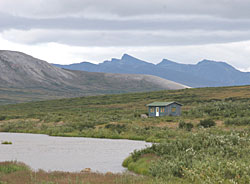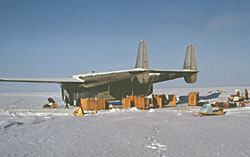Teller Highway
Mile 26–36 Sinuk River to Feather River Bridge
Habitats: Tussock tundra, rocky slopes

Cresting the hill north of the Sinuk River offers a spectacular view of the Kigluaik Mountains on a clear day. Grizzlies den in these rugged, remote mountains. Their river drainages also provide refuge for moose.
Mile 31.7 Permafrost Viewing
Heading north just before Livingston Creek the tundra next to the road has sloughed away, exposing the permafrost beneath the surface layer of tundra plants and soil.
Mile 34 Turn-off
Habitats: Tussock tundra, rocky slopes
A turn-off on your right heading north provides off-road parking and access to tundra ridge hiking with spectacular views of the Kigluaik Mountains.
Mile 36 Feather River Bridge
Habitat types: River valley and dwarf tundra
The Feather River is a rocky, boulder strewn river with steep gradient, fast flow and little vegetation. The landscape seems more barren, probably resulting from the impact of constant wind, long winters and poor soil. The noise from the river helps gauge the difference in this river compared to other locations along the road system. Except for muskoxen, wildlife sightings are less frequent in this drainage.
Muskoxen Release Site

The old road construction camp, gravel mine, and airstrip downstream is where 36 muskoxen transported in crates from Nunivak Island were released in 1970. A second transplant followed in 1981, with the release of 35 muskoxen at the Port Clarence Coast Guard Station, 15 miles west of Teller. The number of muskoxen on the Seward Peninsula is in the range of 3,000, and herds have established themselves throughout the peninsula.
Notable Wildlife
- Muskoxen are often seen alone.
- Arctic grayling are found in these waters.
- Pink salmon only reach the bridge in peak years.
